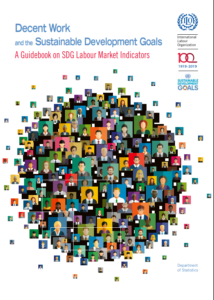Table of Contents
Related pages
Introduction
Numbers on the extent, characteristics and determinants of child labour are provided by the Statistical Information and Monitoring Programme on Child Labour (SIMPOC), which assists countries in the collection, documentation, processing and analysis of child labour relevant data. This page provides extracts of the available information. Refer to the SIMPOC page for a wealth of statistical tools, data and reports. These include questionnaires for child labour surveys, manuals and training kits on how to carry out child labour data collection, guidance on how to process and analyse the collected information, microdatasets and survey reports from around the world, research on statistical issues, and regular trends reports.
Data catalogue
| Indicator | Frequency | Database | Subject | Download (with labels) | Download (with codes) | Data explorer |
|---|---|---|---|---|---|---|
| SDG indicator 8.7.1 - Proportion of children engaged in economic activity and household chores | Annual | SDG Labour Market Indicators (ILOSDG) | Child labour | .csv .dta .xlsx | .csv.gz | |
| SDG indicator 8.7.1 - Proportion of children engaged in economic activity (%) | Annual | SDG Labour Market Indicators (ILOSDG) | Child labour | .csv .dta .xlsx | .csv.gz | |
| Child population by sex and age (thousands) | Annual | Child Labour Statistics (CHILD) | Child labour | .csv .dta .xlsx | .csv.gz | |
| Child population by sex, age and rural / urban areas (thousands) | Annual | Child Labour Statistics (CHILD) | Child labour | .csv .dta .xlsx | .csv.gz | |
| Children in employment by sex and age (thousands) | Annual | Child Labour Statistics (CHILD) | Child labour | .csv .dta .xlsx | .csv.gz | |
| Child population by sex, age and school attendance (thousands) | Annual | Child Labour Statistics (CHILD) | Child labour | .csv .dta .xlsx | .csv.gz | |
| Children in employment by sex, age and rural / urban areas (thousands) | Annual | Child Labour Statistics (CHILD) | Child labour | .csv .dta .xlsx | .csv.gz | |
| Children in employment by sex, age and economic activity (thousands) | Annual | Child Labour Statistics (CHILD) | Child labour | .csv .dta .xlsx | .csv.gz | |
| Children in employment by sex, age and status in employment (thousands) | Annual | Child Labour Statistics (CHILD) | Child labour | .csv .dta .xlsx | .csv.gz | |
| Children in employment by sex, age and school attendance status (thousands) | Annual | Child Labour Statistics (CHILD) | Child labour | .csv .dta .xlsx | .csv.gz | |
| Children in employment not attending school by sex, age and rural / urban areas (thousands) | Annual | Child Labour Statistics (CHILD) | Child labour | .csv .dta .xlsx | .csv.gz | |
| Children in employment attending school by sex, age and rural / urban areas (thousands) | Annual | Child Labour Statistics (CHILD) | Child labour | .csv .dta .xlsx | .csv.gz | |
| Children in child labour by sex and age (thousands) | Annual | Child Labour Statistics (CHILD) | Child labour | .csv .dta .xlsx | .csv.gz | |
| Children in child labour by sex, age and rural / urban areas (thousands) | Annual | Child Labour Statistics (CHILD) | Child labour | .csv .dta .xlsx | .csv.gz | |
| Children in child labour by sex, age and economic activity (thousands) | Annual | Child Labour Statistics (CHILD) | Child labour | .csv .dta .xlsx | .csv.gz | |
| Children in child labour by sex, age and status in employment (thousands) | Annual | Child Labour Statistics (CHILD) | Child labour | .csv .dta .xlsx | .csv.gz | |
| Children in child labour by sex, age and school attendance status (thousands) | Annual | Child Labour Statistics (CHILD) | Child labour | .csv .dta .xlsx | .csv.gz | |
| Children in child labour not attending school by sex, age and rural / urban areas (thousands) | Annual | Child Labour Statistics (CHILD) | Child labour | .csv .dta .xlsx | .csv.gz | |
| Children in child labour attending school by sex, age and rural / urban areas (thousands) | Annual | Child Labour Statistics (CHILD) | Child labour | .csv .dta .xlsx | .csv.gz | |
| Children in hazardous work by sex and age (thousands) | Annual | Child Labour Statistics (CHILD) | Child labour | .csv .dta .xlsx | .csv.gz | |
| Children in hazardous work by sex, age and rural / urban areas (thousands) | Annual | Child Labour Statistics (CHILD) | Child labour | .csv .dta .xlsx | .csv.gz | |
| Children in hazardous work by sex, age and economic activity (thousands) | Annual | Child Labour Statistics (CHILD) | Child labour | .csv .dta .xlsx | .csv.gz | |
| Children in hazardous work by sex, age and status in employment (thousands) | Annual | Child Labour Statistics (CHILD) | Child labour | .csv .dta .xlsx | .csv.gz | |
| Children in hazardous work by sex, age and school attendance status (thousands) | Annual | Child Labour Statistics (CHILD) | Child labour | .csv .dta .xlsx | .csv.gz | |
| Children in hazardous work not attending school by sex, age and rural / urban areas (thousands) | Annual | Child Labour Statistics (CHILD) | Child labour | .csv .dta .xlsx | .csv.gz | |
| Children in hazardous work attending school by sex, age and rural / urban areas (thousands) | Annual | Child Labour Statistics (CHILD) | Child labour | .csv .dta .xlsx | .csv.gz | |
| Share of children engaged in economic activity by sex and age (%) | Annual | Child Labour Statistics (CHILD) | Child labour | .csv .dta .xlsx | .csv.gz | |
| Share of children engaged in economic activity by sex, age and rural / urban areas (%) | Annual | Child Labour Statistics (CHILD) | Child labour | .csv .dta .xlsx | .csv.gz | |
| Share of children engaged in economic activity by sex, age and school attendance (%) | Annual | Child Labour Statistics (CHILD) | Child labour | .csv .dta .xlsx | .csv.gz | |
| Share of children in child labour by sex and age (%) | Annual | Child Labour Statistics (CHILD) | Child labour | .csv .dta .xlsx | .csv.gz | |
| Share of children in child labour by sex, age and and rural / urban areas (%) | Annual | Child Labour Statistics (CHILD) | Child labour | .csv .dta .xlsx | .csv.gz | |
| Share of children in child labour by sex, age and school attendance (%) | Annual | Child Labour Statistics (CHILD) | Child labour | .csv .dta .xlsx | .csv.gz | |
| Share of children in hazardous work by sex and age (%) | Annual | Child Labour Statistics (CHILD) | Child labour | .csv .dta .xlsx | .csv.gz | |
| Share of children in hazardous work by sex, age and rural / urban areas (%) | Annual | Child Labour Statistics (CHILD) | Child labour | .csv .dta .xlsx | .csv.gz | |
| Share of children in hazardous work by sex, age and school attendance (%) | Annual | Child Labour Statistics (CHILD) | Child labour | .csv .dta .xlsx | .csv.gz |
Methods

Child Labour Statistics (CHILD database)
Concise description of concepts and definitions, uses, sources and limitations for the Child Labour Statistics (CHILD) database.

Hard to see, harder to count: Handbook on forced labour surveys
This revised version of the “Hard to see, harder to count” handbook provides an updated set of tools for the design, implementation and analysis of quantitative surveys on the forced labour of adults.


Decent Work and the Sustainable Development Goals: A Guidebook on SDG Labour Market Indicators
This Guidebook provides a detailed overview of the labour market indicators included in the Sustainable Development Goals Global Indicator Framework. It is intended to serve as a manual of best practices for calculating and interpreting the SDG labour market indicators, with a view to monitoring progress made at the national and international levels towards the achievement of the SDGs.

Sampling elusive populations: Applications to studies of child labour
This manual complements the earlier volume on Sampling for household-based surveys of child labour brought out by within the framework of the ILO-IPEC Statistical Information and Monitoring Programme on Child Labour (SIMPOC) and contributes to survey methodology that goes beyond the particular subject of child labour. Thus, anyone interested in issues and practical solutions to problems such as sampling from imperfect frames or sampling difficult populations would benefit from the contents of this Manual.

Sampling for household-based surveys of child labour
This manual presents a wide range of sampling techniques for household-based child labour surveys with a particular emphasis on sampling design and selection procedures.
Analytical publications
Note: Many publications are available only in English. If available in other languages, a new page will open displaying these options.

Child Labour: Global estimates 2024, trends and the road forward
Published for the first time jointly by the ILO and UNICEF, as co-custodians of Target 8.7 of the Sustainable Development Goals, the report takes stock of where we stand in the global effort to end child labour.

